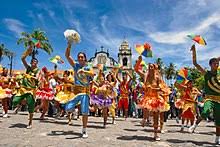Historical-Cultural Explanations for Brazil’s Identity
Brazil is a vast and diverse country, rich in cultural heritage and complex historical influences that have shaped its national identity. From its indigenous roots to the colonization by the Portuguese, the impact of the transatlantic slave trade, and the subsequent waves of immigration, Brazil’s history is marked by a unique blend of cultures, languages, and traditions. These factors have contributed to the development of a multifaceted national identity, characterized by regional diversity, racial and ethnic complexity, and a vibrant cultural landscape.
This article explores the historical and cultural factors that have played a significant role in shaping Brazil’s identity, examining the influence of indigenous peoples, European colonization, African heritage, and immigration. We will also consider the impact of religion, language, and social dynamics on Brazil’s national consciousness.
1. Indigenous Roots: The First Brazilians
Before the arrival of Europeans, Brazil was home to millions of indigenous people belonging to a wide variety of ethnic groups, each with its own languages, customs, and social structures. The Tupinambá, Guarani, Tupi, and Yanomami are just a few of the many indigenous groups that lived in the region. These communities had rich oral traditions, complex religious beliefs, and deep connections to the land and environment.
Indigenous culture still plays a role in Brazil’s identity, although it has been marginalized over time due to colonization and the dominance of European culture. Indigenous words, especially from the Tupi-Guarani languages, have entered Brazilian Portuguese, influencing place names, flora and fauna, and cultural practices. The survival and revival of indigenous traditions, languages, and rights have become an important part of Brazil’s national conversation, especially as indigenous people continue to fight for their land and cultural recognition.
2. Portuguese Colonization: The Foundation of Brazilian Society
The arrival of the Portuguese in 1500, led by explorer Pedro Álvares Cabral, marked the beginning of a new era in Brazil’s history. The Portuguese claimed the territory for their crown and began a process of colonization that would last for over three centuries. During this period, Brazil became a major part of the Portuguese Empire, and Portuguese culture, language, and Catholicism became the dominant forces shaping the emerging society.
Language is one of the most enduring legacies of Portuguese colonization. Brazil is the largest Portuguese-speaking country in the world, and the language serves as a unifying element in a country with such vast geographic and cultural diversity. Brazilian Portuguese, however, evolved differently from the European version, incorporating words and expressions from indigenous languages, African languages, and other immigrant influences, creating a unique dialect.
The Catholic Church also played a central role in the formation of Brazilian society. Catholicism became the official religion during colonization, and it influenced the country’s social structure, values, and festivals. Many of Brazil’s most important holidays, such as Carnival and Christmas, have roots in Catholic traditions. The Church also played a significant role in education and governance during the colonial period.
3. The African Diaspora: A Cultural Force
Perhaps the most profound influence on Brazilian culture and identity comes from the African diaspora. Between the 16th and 19th centuries, Brazil was one of the largest destinations for enslaved Africans, with an estimated 4.8 million people forcibly brought to the country to work primarily in sugarcane plantations and the mining industry. This dark chapter in Brazil’s history had long-lasting effects on the country’s demographic makeup, culture, and social structure.
Today, Brazil has the largest population of African descent outside of Africa, and African heritage is a defining aspect of the nation’s identity. African influence is evident in Brazilian music, religion, dance, cuisine, and language. Samba, capoeira, and candomblé are just a few examples of cultural elements that have roots in African traditions and have become iconic aspects of Brazilian culture.
In terms of religion, many Afro-Brazilians practice syncretic religions such as Candomblé and Umbanda, which blend elements of African spirituality with Catholicism. These religions, which were historically suppressed, have gained wider acceptance in modern Brazil and are celebrated as integral parts of the nation’s cultural fabric.
Carnival, Brazil’s most famous festival, also has deep connections to African culture. Originally a Catholic holiday, it has evolved into a national celebration where samba music and dance—both heavily influenced by African rhythms—take center stage. The vitality and resilience of African culture in Brazil, despite centuries of oppression, is a testament to its profound impact on the country’s identity.
4. Immigration: A Mosaic of Cultures
In the late 19th and early 20th centuries, Brazil experienced waves of immigration from Europe, the Middle East, and Asia, which further diversified its population and culture. Italian, German, Spanish, Japanese, and Lebanese immigrants, among others, arrived in Brazil seeking economic opportunities and contributed to the country’s cultural mosaic.
Italian and German immigrants settled in the southern states, where they established farming communities and brought their languages, food, and customs. Italian influence is particularly strong in São Paulo, where the descendants of Italian immigrants have had a significant impact on the city’s culture and economy. German immigrants, concentrated in states like Rio Grande do Sul and Santa Catarina, introduced Oktoberfest celebrations and beer-making traditions that are now part of local culture.
Japanese immigration to Brazil, which began in the early 20th century, has also left a lasting legacy. Brazil has the largest Japanese population outside of Japan, and Japanese-Brazilians have contributed to the country’s economy, particularly in agriculture, as well as to its cultural diversity. The integration of sushi into mainstream Brazilian cuisine and the popularity of Japanese cultural festivals like the Bon Odori reflect this influence.
Middle Eastern immigrants, particularly from Lebanon and Syria, also played a role in shaping Brazil’s commercial landscape, especially in the retail and textile industries. Their descendants have become prominent figures in Brazilian business and politics, further enriching the cultural tapestry of the nation.
5. Religion and Spirituality: A Pluralistic Society
Religion is a significant element of Brazilian identity, with Catholicism remaining the dominant faith, although the country has become increasingly pluralistic. In recent decades, there has been a rise in Evangelical Protestantism, particularly among Brazil’s lower and middle classes. Evangelical churches have gained political and social influence, and their growing presence has sparked debates about the role of religion in public life.
In addition to Catholicism and Protestantism, Afro-Brazilian religions like Candomblé and Umbanda continue to thrive, especially in the northeastern states. These religions, rooted in African spiritual practices, are often practiced alongside Catholicism in a process of religious syncretism. This blending of religious traditions is a hallmark of Brazilian spirituality and reflects the country’s broader cultural fusion.
Brazil also has significant populations of Muslims, Jews, Buddhists, and adherents of indigenous religions, further contributing to the country’s religious diversity. This pluralism is celebrated in Brazil’s constitution, which guarantees freedom of religion and fosters a society where multiple faiths coexist.
6. Regionalism and Identity
Brazil’s vast geography has given rise to distinct regional identities, each with its own cultural practices, cuisine, music, and social norms. The northeast, for example, is known for its Afro-Brazilian heritage, vibrant Carnival celebrations, and forró music. The southeast, particularly São Paulo and Rio de Janeiro, is more industrialized and cosmopolitan, while the southern states have strong European influences due to immigration from Italy and Germany.
The Amazon region in the north is home to Brazil’s largest indigenous population, and its culture is deeply intertwined with the rainforest and indigenous traditions. Meanwhile, the pantanal region in the center-west is known for its cowboy culture and wildlife, reflecting the rural and agricultural heritage of the area.
This regional diversity is a key aspect of Brazilian identity, and while Brazil is a unified nation, its people often express pride in their regional roots. Regionalism can also lead to political and economic divisions, as different areas of the country face unique challenges related to development, infrastructure, and social services.
7. Modern Brazilian Identity: Unity in Diversity
Today, Brazil’s national identity is defined by its diversity. The country’s motto, “Ordem e Progresso” (Order and Progress), reflects the ideals of unity and development, but in practice, Brazil is a land of contrasts—rich and poor, urban and rural, traditional and modern. Brazilians take pride in their country’s cultural pluralism, which is expressed in its music, food, festivals, and social interactions.
Brazilian identity is fluid, shaped by a continuous process of cultural exchange and adaptation. Whether it’s the vibrant Afro-Brazilian culture of Bahia, the European traditions in the south, or the indigenous heritage in the Amazon, Brazil’s people have learned to embrace their differences while finding common ground in their shared history.
Conclusion
Brazil’s national identity is the result of a complex historical and cultural process that spans centuries. Indigenous traditions, Portuguese colonization, African influences, and waves of immigration have all played a crucial role in shaping the country’s unique character. Today, Brazil stands as a multicultural nation where regional diversity and racial mixing are celebrated as core elements of its identity.
As Brazil continues to evolve, the historical-cultural forces that have shaped its past will remain essential in understanding its present and future. The interplay of different cultures, traditions, and histories has given rise to a dynamic society, and Brazil’s identity will continue to reflect this rich and diverse heritage for generations to come.


